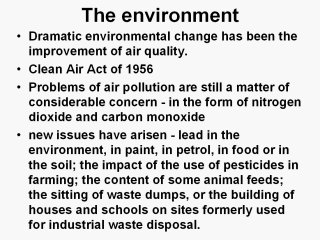| front |1 |2 |3 |4 |5 |6 |7 |8 |9 |10 |11 |12 |13 |14 |15 |16 |17 |18 |19 |20 |21 |22 |23 |24 |25 |26 |27 |review |
 |
The most dramatic
environmental change has been the improvement of air quality. Until the
Clean Air Act of 1956, most of our urban areas were covered by a pall of
dirty black smoke in the winter months. This resulted in many episodes of
so-called “smog”. But in spite of this major improvement in air quality, and thus in the frequency of respiratory illness in both young and old, problems of air pollution are still a matter of considerable concern - in the form of nitrogen dioxide and carbon monoxide rather than sulphur and soot. Past problems with both domestic and public hygiene in terms of adequate sanitation, sewage and water supplies have largely been rectified. But new issues have arisen - lead in the environment, in paint, in petrol, in food or in the soil; the impact of the use of pesticides in farming; the content of some animal feeds; the siting of waste dumps, or the building of houses and schools on sites formerly used for industrial waste disposal. |